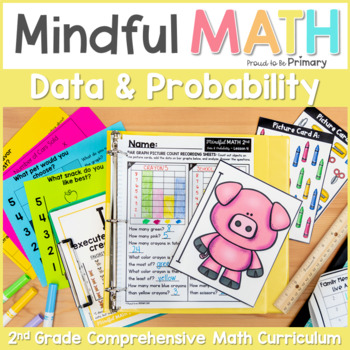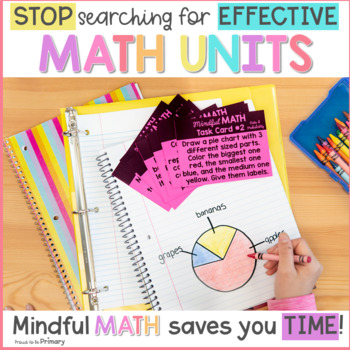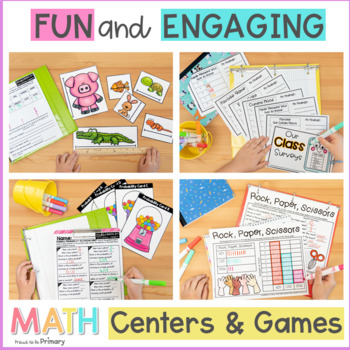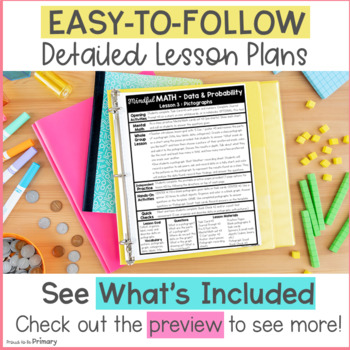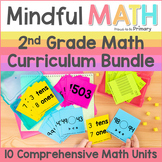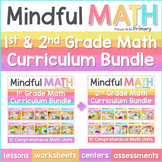Grade 2 Math - Data, Graphing, & Probability - 2nd Grade Math Lessons & Centers
- PDF
What educators are saying
Also included in
- Mindful Math is a comprehensive, differentiated second grade math curriculum with 10 units. Students will have many opportunities to learn and practice new strategies and develop math fluency through whole group lessons, math worksheets, mental math, journal prompts, math centers, math games, and moPrice $99.00Original Price $154.85Save $55.85
- Mindful Math is a comprehensive, differentiated first grade & second grade guided math year long curriculum with 21 units. Grade 1 and 2 students will learn and practice new strategies and develop math fluency through whole group lessons, math worksheets, mental math, journal prompts, math centePrice $180.00Original Price $295.70Save $115.70
- Mindful Math is a comprehensive, differentiated kindergarten, first grade, & second grade guided math year long curriculum with 31 units. Kindergarten, grade 1, and grade 2 students will learn and practice new strategies and develop math fluency through whole group lessons, math worksheets, mentPrice $247.50Original Price $423.00Save $175.50
Description
This Mindful Math Second Grade Data, Graphing, and Probability unit is a comprehensive math curriculum that was designed to be teacher and student-friendly and includes 8 lessons to teach the beginning concepts and strategies related to data and probability (tally charts, pie charts, pictographs, bar graphs, line plots, likelihood of everyday events, and probability in simple games).
It was created to give teachers a ready-to-teach math curriculum that is fun, engages minds, and leaves students knowledgeable and fluent in math concepts.
Go from boring, complicated math to lessons that are enjoyable, effective, and easy to use. This comprehensive, differentiated unit has everything you need to teach the second-grade standards.
This ready-to-teach unit of teacher-tested, hands-on math curriculum provides teachers with EVERYTHING they need to teach second-grade math with no need to supplement from other sources.
Mindful MATH includes thoughtful lessons and activities to help meet the needs of different learning styles. Students will have many opportunities to learn and practice new strategies and develop math fluency through whole group warm-ups, lessons, mental math, journal prompts, math centers, math games, and more.
This unit is included in Mindful Math for 2nd Grade math. Check out the Mindful MATH 2nd Grade Curriculum BUNDLE available at a HUGE discount NOW!
Mindful MATH for 2nd Grade has what teachers LOVE!
⭐Easy to implement, effective lesson and activities that kids enjoy!
⭐Detailed, easy-to-teach lesson plans that take the guesswork out of what to teach!
⭐ALL lesson materials provided so you don't have to waste time gathering supplies!
⭐"I CAN" concept posters to introduce topics so your students understand concepts more easily!
⭐A variety of activities for every lesson (math games and centers) to keep engagement high!
⭐Build math skills and develop fluency with math journals, task cards, mental math, and TONS of differentiated practice printables!
⭐2 types of assessments - Quick Check review cards + Pre & Post Tests for every lesson so you can check that your students understand what they need to know!
Teachers will create SUCCESS with all that is included with every unit of Mindful MATH!
⭐Lesson Overview
An explanation of the parts of a lesson plan and how they can be used.
⭐Unit Overview
A list of the 8-10 math lessons included and what curriculum standards they cover with the US Common Core, as well as B.C.'s and Ontario's curriculum.
⭐Lesson Plans
Mindful MATH lesson plans provide teachers with a detailed plan to follow from start to finish. Instructions for whole group math lessons, individual math practice, and follow up activities are given. Also included are lesson goals, vocabulary, questions to ask, material list, and book suggestions to match concepts.
⭐Lesson Materials
All the extra materials needed for teaching a lesson and student practice are provided. Math manipulatives and tools, such as words, ten frames, number lines, are included to support students and the lesson.
Chart pieces and "I Can" concept posters are provided to support lesson instruction.
⭐Warm-Up Task Cards
Mindful Math task cards are short math warm-up activities that students can complete independently. There are a variety of tasks that build on skills previously taught in other lessons to build fluency.
⭐Journal Prompts
Mindful Math Journal Prompts are perfect for a warm-up activity, for extra practice, or for homework. Each prompt reviews the skills and concepts taught in the previous lesson. They make a great review activity and help build math understanding.
⭐Mental Math
Mindful Math mental math cards are perfect for building mental math skills and quick recall of important math concepts. Mental math cards are provided and suggested to use as a whole group as a warm-up activity.
⭐Practice Printables
Every lesson in Mindful Math includes practice printable pages for students to complete independently following a lesson. The pages help build math skills and review important concepts. The pages range in difficulty to allow for differentiation.
⭐Hands-On Activities (Math Centers and Games)
Each lesson includes math games, activities, and centers. The lesson plans and activity cards provide instructions on how to use.
⭐Assessments
Mindful Math Quick Checks are assessments that can be performed after math lessons and practice. Each Quick Check includes a short activity for individual or small groups to complete and show to the teacher. Pre & post-tests are also included for more formal assessment. Also includes a template to keep track of student scores.
⭐Supplemental Materials (Answer Key & Book List, & Canadian pages)
Answer keys are provided to help teachers assess and check the practice printable pages, as well as the pre & post-test assessments.
A suggested book list is provided with children’s literature to help teach math concepts.
Extra pages are provided for Canadian teachers with Canadian spelling and content (coins and money, for example).
USA BUYERS: The curriculum aligns with the U.S. Common Core standards. This unit covers Second Grade standards and builds on to those skills with challenges and rigor.
CANADIAN BUYERS: Mindful Math also aligns with the Canadian math curriculum in British Columbia and Ontario (Curriculum standards are included and matched to lessons within the product). Please see the PDF Preview for a breakdown of what standards are covered in this unit.
**EXTRA PAGES FOR CANADIAN CONTENT AND SPELLING ARE PROVIDED.**
Lessons Included in Data & Probability for 2nd Grade:
1✭ TALLY CHARTS: Collect, organize, read and describe data
2✭ PIE CHARTS: Collect, organize, read and describe data
3✭ PICTOGRAPHS: Collect, organize, read and describe data
4✭ BAR GRAPHS: Collect, organize, read and describe data
5✭ LINE PLOTS: Collect, organize, read and describe measurement data
6✭ PROJECT: Collect, organize, read, & describe your own collected data
7✭ Probability in everyday situations
8✭ Probability in simple games
Check out the ENGAGING & MINDS-ON activities included in the Data and Probability unit:
- Task cards
- "I Can" concept posters
- Interactive math journal pages
- Printable practice pages
- Class graphing activities, anchor chart templates, and recording sheets
- Tons of hands-on opportunities for graphing
- Class surveys
- Hands-on, interactive centers
- Graphing project materials
- Tons of games - Scoot, Rock, Paper, Scissors, Spinners, Dice, and more
- Book suggestions
- Pre & post-tests for every lesson
- & much MORE!
FAQ:
How do you set it up and organize all the materials?
Check out the info guide HERE! See a breakdown of what is included, how to use, implement, and organize it and read the frequently asked questions.
How do you differentiate with Mindful Math?
Mindful Math includes many opportunities and options for differentiation. Lessons encourage students to show their understanding in different ways and practice math concepts with or without supports. The curriculum includes many practice pages with different levels of difficulty, as well as a variety of activities, games, and centers.
Are digital resources included in this curriculum?
This is a printable program. However, you can now create your own digital activities using the TPT Digital Tool to assign pages to Google Classroom by clicking the ‘Create Digital Activity’ button on the product page.
Check out other second grade Mindful Math units:
Number Sense (Numbers to 100 & 1000)
2-Digit Addition (with and without regrouping)
2-Digit Subtraction (with and without regrouping)
Geometry 2D Shapes & 3D Figures & Fractions
3-Digit Addition (with and without regrouping)
3-Digit Subtraction (with and without regrouping)
Measurement (Metric & Imperial) & Time
Money to 500¢ (coins & bills) - US & Canadian Money
Stay connected with Proud to be Primary
♥Never miss a sale or new release! Click the green star to follow my store!
♥Join our email list and get exclusive content and FREE resources.
♥Visit our website at Proud to be Primary for engaging ideas!
Have a question or need help with a file?
Visit the FAQs section, submit a help ticket, or ask a question on the Q& A tab before leaving feedback. Please ask all questions before purchasing.
Terms of Use: This product is licensed for single classroom use ONLY unless multiple licenses are purchased. Your purchase grants you a license to use in a secure, password-protected online platform (such as Google Classroom) with your students only. You may not transfer or share with another teacher or use it for commercial purposes (Outschool, etc.).
Copyright ©2013 to Present - Proud to be Primary - Elyse Rycroft

